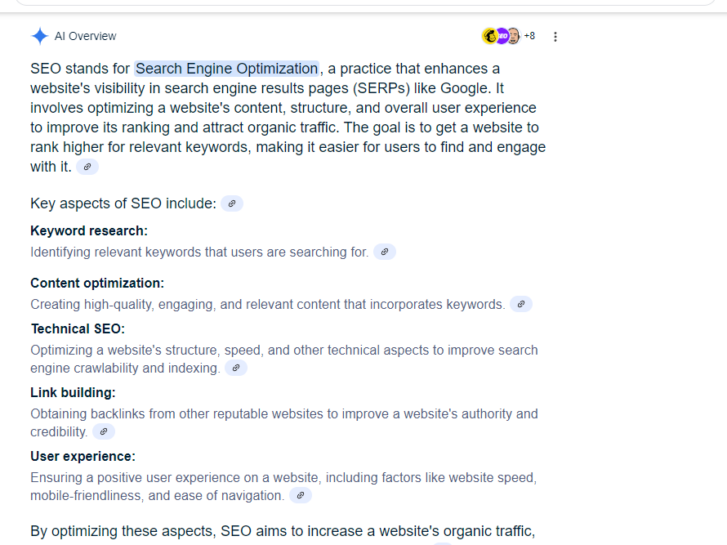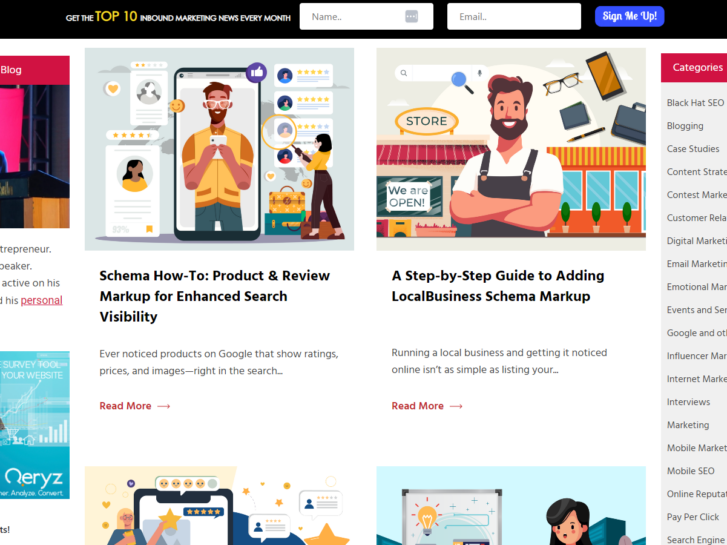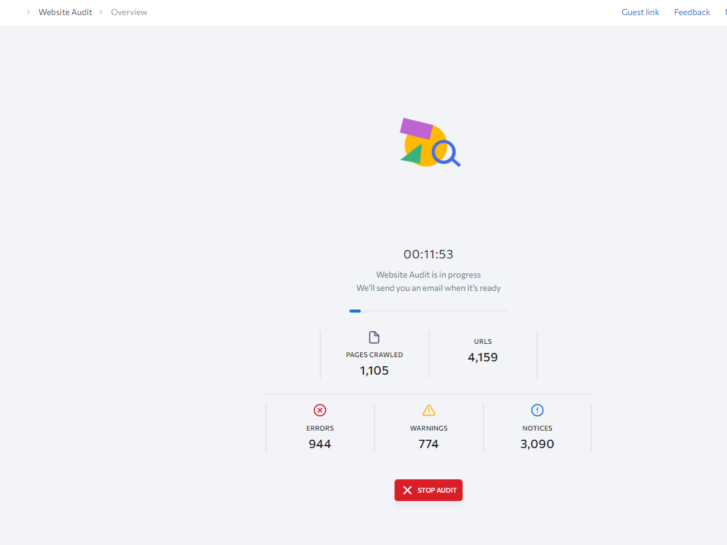Back in 2024, Google CEO Sundar Pichai pushed for the company’s move towards AI-powered search. A move that started with Google Bard, then Gemini, then AI Overview.
Back in 2024, I also shared my thoughts on where AI and SEO were headed and how AI chatbots were about to reshape search as we knew it. I predicted that AI-generated answers would take over Rank 0—and sure enough, AI Overviews made that prediction a reality.
Now, Google is entering its next phase: AI Mode. First tested in Google Labs just three months ago, this Gemini-powered experience is rolling out to the public, bringing yet another major shift in how search works—and challenging us SEOs to adapt fast.
In this article, I’ll unpack what AI Mode is, how it interacts with today’s search engines and content platforms—and more importantly, show you how to evolve your SEO strategy for this new era of AI-driven discovery.
Is SEO Still Relevant in the Age of AI?
With the rise of so many AI-powered search features like AI Overview and AI Mode, many website and business owners are asking the same thing: Is SEO still worth the effort? Do I even bother investing my time (and money) in it?
It’s a valid concern. AI is reshaping how people search, and as Google leans into generative results over traditional link listings, it’s easy to see why many fear organic visibility might take a hit. Over the past year, I’ve seen plenty of webmasters scrambling as traffic dips and blue links become harder to find on the SERPs.
But here’s the truth: AI has been part of Google Search for nearly a decade.
Since the introduction of RankBrain in 2015, followed by BERT and other machine learning systems, Google has quietly become better at understanding natural language, user context, and intent. We’ve all been optimizing for AI—whether we realized it or not.
So yes, SEO is still worth it in 2025 (and likely will be for the years to come).
Now some SEOs will take this opportunity to say that not only is this practice still worth it, but also optimizing for AI Overviews or conversational platforms isn’t anything new, it’s just SEO as usual.
But the reality is, AI Mode marks a turning point. It changes how search works, how users get answers, and what it means to be visible on Google. This isn’t just another tweak. It’s a shift in the entire search experience.
What is AI Mode?
For us to understand why it presents a new search experience, I have to explain the mechanisms behind AI Mode.
Powered by a custom Gemini 2.0 model, AI Mode builds on AI Overviews with stronger reasoning, multimodal abilities, and support for complex user queries. It combines Gemini’s advanced AI with Google’s vast search infrastructure for smarter, more dynamic results.
Let’s break down what that means. AI Mode can:
- Interpret a combination of input types, such as text, images, or potentially even voice.
- Pull information from various sources like web pages, real-time data (e.g. shopping listings), structured databases (like the Knowledge Graph), and visual content (e.g. product images).
- Generate responses that blend different formats, like summaries with images, charts, product comparisons, or links.
In short, instead of doing multiple searches, AI Mode handles layered or multi-step questions and helps you explore topics or make decisions in less keystrokes and clicks. It’s ideal for research, comparison, and follow-ups, not just quick answers.
This is brought together using what’s called a “query fan-out” approach, where Google breaks your question into smaller parts and checks multiple sources at once, to gather the most relevant information from different sources.
For SEO specialists, there’s a shift from the static, rule-based ecosystem that everyone was used to, into a more dynamic system that learns, predicts and generates information and content in real time.
You don’t have to take my word for it. You can test AI Mode yourself now if you’re in the US.
AI Mode vs AI Overview
Where AI Overviews emphasize content credibility and consensus, AI Mode is laser-focused on personal relevance.
Mike King has a full run-through of how AI Mode and AI Overviews work, going over the workflows that are likely used to generate answers for users. It’s well worth the read if you want the full picture.
But if you’re just looking for a quick breakdown, here’s a summary of how AI Overviews and AI Mode work, and how they compare:
AI Overview: The Generate-First, Verification-Backed Process
Information Retrieval Process
- Receive query → User enters a search.
- Generate summary (LLM) → The system immediately creates a natural language answer.
- Select segments to verify → It picks out key parts of the summary that need fact-checking.
- Retrieve candidate sources → It looks for sources to support its answer by:
- Matching with already found pages, or
- Doing new searches based on the summary.
- Check for verification → It compares what it found with the summary to see if the facts match.
- Verify or retry → If verified, it’s cited; otherwise, it tries more sources.
- Linkify verified claims → Verified parts get linked to sources, with clickable highlights.
- Repeat for all segments → It does this for each part of the summary to ensure accuracy.
- Render AI Overview → You see a final, fact-checked answer with sources.
Key Characteristics
- Generative-first: Starts with an LLM-generated summary before checking sources.
- Cited post-verification: Content gets cited only after supporting the generated claim.
- Passage-level competition: You don’t need to dominate a full page—single sentences can earn citations.
- Content must be chunk-level verifiable: Precise, factual, and semantically clear writing wins.
AI Mode: Personalized, Contextual Retrieval and Generation
Information Retrieval Process
- Collect user data → Info like your search history, clicks, location, and how you use Google.
- Create user embedding → Builds a vector profile (a mathematical representation of a user’s preferences, past behavior, and query context) from this data. This that helps the AI understand your interests and behavior.
- Receive task (query) → User submits a prompt or query.
- Embed query → The AI turns your question into a format it can understand (kind of like a “meaning map”).
- Fuse user + query embeddings → It combines your profile with your question to better understand what you’re asking and what matters to you.
- Retrieve/generate personalized response → The AI gives you a result tailored to your needs and context.
Key Characteristics
- Personalization-first: Tailors responses based on the user’s history and preferences.
- Query + persona fusion: Two users asking the same thing may get totally different answers.
- Memory-enabled search: Prior behavior and interests shape what content gets surfaced or synthesized.
- Vector-based filtering: AI mode uses “vector-based filtering,” a technique that matches user intent and content meaning using patterns and context, not just keywords.
To summarize:
|
Feature / Aspect |
AI Overview |
AI Mode |
|
Process Type |
Generate first, then verify. |
Personalize first, then generate. |
|
Response Generation |
Begins with LLM summary → verified by content. |
Generated using fused embeddings (user + query). |
|
Citation Source |
Post-verification citations from third-party content. |
May or may not include external citations; focus is on personalization. |
|
User Personalization |
Minimal or none. |
Deeply personalized using historical embeddings. |
|
Retrieval Method |
Query fan-out with summary chunks. |
Query fan-out with user behavior shaping the scope. |
|
SEO Implication |
Content must be verifiable, fact-rich, chunked clearly. |
Content must align with diverse intents and user personas. |
|
Ranking Concept |
Citation = new rank. |
Visibility depends on match with user embedding. |
|
Optimization Focus |
Verifiable passages; LLM-compatible language. |
Multi-persona coverage; semantic richness; adaptive formats. |
How AI Mode Changes the Search Experience (and SEO)
The biggest shift with AI Mode isn’t just how results look—it’s how search thinks.
Traditional search was deterministic: Google crawled, indexed, and displayed your content largely as-is. Visibility came from optimizing known factors like keywords, structure, links, and metadata.
AI Mode introduces probabilistic, generative retrieval. Instead of showing content directly, Google interprets it—remixing, selecting, and stitching together pieces from multiple sources to generate a new response. You’re no longer competing for a spot in a list of links—you’re competing for inclusion in the answer itself.
Content must now pass through a complex pipeline: understanding user context, generating synthetic queries, classifying intent, selecting relevant passages, running reasoning chains, and synthesizing a response. Even then, your content being cited in the final output isn’t guaranteed.
The system is dynamic, adapting in real time based on user behavior, context, and memory-based embeddings.
In short: AI Mode redefines SEO. It’s no longer just about ranking—it’s about being understood, selected, and synthesized. That requires a more strategic, deeply structured approach to content, signals, and topical authority.
The SEO Implications of Highly Personalized Search Results
Personalized search isn’t new—Google’s been factoring in your location, search history, and behavior for years. But AI Mode takes personalization to a whole new level.
In this new environment, two users entering the same query could receive completely different answers—not just reordered links, but entirely different outputs.
Ranking is no longer global; it’s contextual and individualized. The idea of being the “#1 result” becomes meaningless if your content only surfaces for certain types of users. Traditional rank tracking tools won’t cut it—you’ll likely need to simulate user personas to understand where and how your content appears.
What truly sets AI Mode apart is that it doesn’t just re-rank results—it generates different answers based on user context. Your page might be invisible in one result but play a starring role in another because it fits that user’s intent, behavior, or history better.
What This Means for SEO:
This is where classic SEO tactics start to fall apart.
- Content built for one-click answers or shallow intent won’t survive.
- If your page doesn’t help answer complex, layered questions or guide users through a logical thought process (called “multi-hop reasoning”), it likely won’t be included in AI-generated answers.
- To win, your content needs to be rich in entities, relationships, and layered meaning—capable of supporting nuanced questions and logical progression.
Adapting Your SEO for AI Mode Means:
- Optimizing for user personas, not just keywords.
- Structuring your content to be flexible and dynamic, ready to serve different user needs and contexts.
- Considering producing multiple content variants to align with the spectrum of searcher intent.
The age of one-size-fits-all SEO is over. We’re entering an era of fractured, highly personalized discovery—and those who understand how to align with that system will win.
Future-Proofing Your SEO for AI Mode
What you do today can position you for visibility tomorrow. Here’s how to build long-term value in the AI era:
Structure Your Content for AI Understanding
AI mode thrives on clear structure. Format your content to be easily scannable and digestible:
- Make sure to use descriptive H2s and H3s for AI to better understand your content
- Add bullet points and tables to structure and provide all the information AI needs
- Implement schema markup (especially FAQ and HowTo’s)
- Make sure your answers are concise and full of facts.
This makes your content easier for AI to extract, reference, or summarize the content you provide and in turn provide it to the users.
Double Down on EEAT
Google’s Search Quality Rater Guidelines emphasize Expertise, Experience, Authoritativeness, and Trustworthiness (EEAT). AI Mode seems to reflect those values.
- Include bylines and bios
- Cite primary data or research
- Publish firsthand experiences or local insights
- Show industry credentials or real-world examples
The key is to create content that delivers information gain—offering fresh insights, original research, real case studies, or expert takes that go beyond what’s already out there.
Build Topical Depth
Instead of publishing isolated pages, build out entire topic clusters—including subtopics, FAQs, in-depth guides, and long-form articles—to demonstrate topical authority. Interlink these pages to highlight semantic relationships, helping AI better understand your site’s expertise and coverage.
To strengthen content depth, weave in relevant entities like people, organizations, locations, and key concepts. This signals contextual relevance and reinforces your authority within the topic.
Build User Personas
Beyond structure and coverage, consider how different user personas might engage with your content. What specific information are they looking for? What would they have previously searched to arrive at this specific topic? What follow-up questions might they ask after finding an answer?
Creating and referencing detailed personas can guide your strategy and ensure your content resonates across varying user intents.
Use Chain of Thought
AI Mode uses its own version of Chain of Thought to answer complex questions at every step. Understand how AI Mode might reason through a query and see whether your content supports the steps in that reasoning chain.
The first step is to pick a question or topic that your content targets — preferably something complex or layered. For example, “How can businesses improve organic search traffic using AI tools?”
Think like an LLM. Break the query into logical sub-questions a machine might ask to build a full answer.
Example Chain of Thought Steps:
- Why is organic traffic important for businesses?
- What are free AI tools relevant to SEO and organic growth?
- What are paid AI tools relevant to SEO and organic growth?
- How can each of these tools be used in an SEO workflow?
- What are the benefits of using AI tools in organic search?
- Are there real examples or case studies?
- What are best practices or warnings when using AI in SEO?
Write these steps out in a doc or spreadsheet. If you have content for this topic already, go through your blog posts, guides, or pages and highlight which paragraphs/passages relate to each reasoning step.
If not, then you can then determine if there is enough content to write posts for each question, or if they’re better off clustered together in a longer post.
Think of Query Classification
Search is still an experiential product, wherein Google aims to provide what the user wants — a quick fact, a detailed explanation, a product, or something fun to read.
This process is called query classification — sorting searches by intent. Most SEO tools still group search queries into old-school buckets like:
- Navigational (looking for a specific website),
- Informational (looking for answers), or
- Transactional and Commercial (ready to buy).
But this is pretty limiting, and doesn’t reflect how complex search intent can be nowadays. But AI Mode and AI Overview answers will change depending on the type of query. If your content doesn’t match the intent, it might get ignored.
So: manually review search queries and ask: “Is this person asking for a fact, explanation, choice, or something else?” Then create content that fits that purpose.
Optimize for Summary & Citation
In generative search, AI models will attempt to answer the user directly, pulling key ideas from content across the web. If your content is easy to parse and provides clear value, it’s more likely to be included in those summaries.
Write sections that are easily quotable or can be referenced. Make it easy for AI to summarize your content accurately without distorting your message. Specifically answer key questions clearly at the beginning of sections.
Use AI as a Strategic Co-Pilot
AI can be a powerful partner for brainstorming, topic clustering, and fine-tuning your on-page SEO. Tools like SE Ranking can help you audit your website to identify potential keywords, content gaps, and other opportunities to target. AI-powered plugins, like Wordlift, can also help you transform your content so it’s easily digestible by search engines.
But like any tool we’ve created, AI is meant to enhance our work—not replace the creativity and critical thinking that only humans bring to the table. It’s easy to get comfortable and overly dependent on automation, but the real edge comes from using these tools as a way to enhance your workflows for maximum efficiency.
Experiment with Prompt Optimization
If you’re using AI tools to generate outlines for your content (as almost every other webmaster is doing nowadays), it’s not just about searching using Chat GPT, you have to learn to write effective prompts.
The better your prompt, the better the output and the faster your SEO workflow becomes. Prompt engineering is becoming a valuable skill for content teams.
Humanize Your Content
AI-generated content is all over the internet—but human authenticity is still rare and valuable. Add anecdotes, cultural references, and brand voice. Localize your content. Inject your own personality, own your content, and make it feel genuine. . These things help you stand out to both readers and search engines.
As Mike King in an article in iPullRank puts it: “You don’t win in AI Mode by creating the best content for machines. You win by creating content that machines can extract from—and that people want to engage with.”
Key Takeaway
The future of SEO isn’t about stuffing keywords or chasing backlinks, it’s about adapting to how AI Mode understands and serves content.
That means creating pages that AI can easily extract from, that reflect genuine human expertise, align with real user intent, and build long-term trust.
While AI is powerful, your personal insights and lived experiences are irreplaceable. When you combine human depth with machine intelligence, your SEO strategy doesn’t just survive the shift—it helps lead it.
The post SEO & AI Mode: How It Works & How to Adapt Your Strategy appeared first on SEO Services Agency in Manila, Philippines.
















